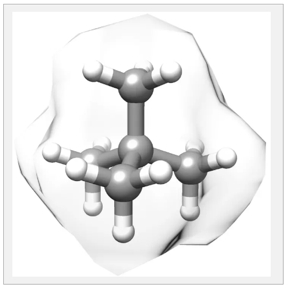Home > Press > A simple, inexpensive way to make carbon atoms bind together: A Scripps Research team uncovers a cost-effective method for producing quaternary carbon molecules, which are critical for drug development
 |
| An image of tert-butane, the simplest quaternary carbon.
CREDIT Scripps Research |
Abstract:
The active ingredient in many drugs is whats known as a small molecule: bigger than water, much smaller than an antibody and mainly made of carbon. Its tough, however, to make these molecules if they require a quaternary carbona carbon atom bonded to four other carbon atoms. But now, Scripps Research scientists have uncovered a potential cost-effective way to produce these tricky motifs.
A simple, inexpensive way to make carbon atoms bind together: A Scripps Research team uncovers a cost-effective method for producing quaternary carbon molecules, which are critical for drug development
La Jolla, CA | Posted on April 5th, 2024
In the new findings, which were published in Science on April 5, 2024, Scripps Research chemists show that its possible to convert feedstock chemicals into quaternary carbons using a single, inexpensive iron catalyst. This method could benefit drug developers by making molecules cheaper and easier to produce at small and large scales.
Quaternary carbons are ubiquitous across various areas of researchfrom drug discovery to material science, says co-first author Nathan Dao, a PhD candidate at Scripps Research. The synthesis of quaternary carbons, however, is a long-standing challenge in the field of organic chemistry, typically requiring numerous steps and relying on harsh conditions or less accessible starting materials.
In addition to Dao, the studys co-first authors included Xu-Cheng Gan and Benxiang Zhang.
Catalysts are substances used to speed up the rate of a chemical reaction. Sometimes, several different catalysts are necessary to promote a certain reaction and obtain the desired result: a veritable reaction soup. But catalysts can be very expensive, and they dont always react as intendedand the more catalysts used, the more waste thats produced. But the Scripps Research scientists determined that a single catalyst could perform multiple crucial rolls.
A difficult chemical reaction often requires many interacting components, according to co-senior author, Ryan Shenvi, PhD, a professor in the Department of Chemistry at Scripps Research. A benefit of this work is it’s incredibly simple.
The team identified simple conditions to convert carboxylic acids and olefins, two major classes of chemical feedstocksor raw materials that fuel a machine or industrial processinto quaternary carbons by using an inexpensive iron-based catalyst. In addition, these chemical feedstocks arent only abundant, but theyre also low cost.
Similar reactions have been gaining traction lately, so this discovery was inevitable, Shenvi explains. The pieces were already in the literature, but no one had put them together before.
Overall, the study, which was done in collaboration with the lab of senior co-author Phil Baran, PhD, the Dr. Richard A. Lerner Endowed Chair in the Department of Chemistry at Scripps Research, highlights the ongoing role of chemistry in the development of modern technology and pharmaceuticals.
This work is yet another striking demonstration of the power of the collaborative atmosphere at Scripps Research to unearth new transformations that can have a dramatic impact on simplifying the practice of organic synthesis, Baran adds.
This work and the researchers involved were supported by funding from the National Institutes of Health (grants GM122606 and GM118176), the National Science Foundation (CHE1955922), Nanjing King-Pharm Co., Ltd), Pfizer and Biogen.
####
For more information, please click here
Contacts:
Scripps Research Communication Office
Scripps Research Institute
Copyright © Scripps Research Institute
If you have a comment, please Contact us.
Issuers of news releases, not 7th Wave, Inc. or Nanotechnology Now, are solely responsible for the accuracy of the content.
News and information
![]()
Simulating magnetization in a Heisenberg quantum spin chain April 5th, 2024
![]()
NRL charters Navys quantum inertial navigation path to reduce drift April 5th, 2024
![]()
Discovery points path to flash-like memory for storing qubits: Rice find could hasten development of nonvolatile quantum memory April 5th, 2024
![]()
Good as gold – improving infectious disease testing with gold nanoparticles April 5th, 2024
Synthetic Biology
![]()
New micromaterial releases nanoparticles that selectively destroy cancer cells April 5th, 2024
![]()
Rice University launches Rice Synthetic Biology Institute to improve lives January 12th, 2024
Possible Futures
![]()
Discovery points path to flash-like memory for storing qubits: Rice find could hasten development of nonvolatile quantum memory April 5th, 2024
![]()
With VECSELs towards the quantum internet Fraunhofer: IAF achieves record output power with VECSEL for quantum frequency converters April 5th, 2024
![]()
Chemical reactions can scramble quantum information as well as black holes April 5th, 2024
Discoveries
![]()
Chemical reactions can scramble quantum information as well as black holes April 5th, 2024
![]()
New micromaterial releases nanoparticles that selectively destroy cancer cells April 5th, 2024
![]()
Utilizing palladium for addressing contact issues of buried oxide thin film transistors April 5th, 2024
![]()
Good as gold – improving infectious disease testing with gold nanoparticles April 5th, 2024
Announcements
![]()
NRL charters Navys quantum inertial navigation path to reduce drift April 5th, 2024
![]()
Discovery points path to flash-like memory for storing qubits: Rice find could hasten development of nonvolatile quantum memory April 5th, 2024
![]()
With VECSELs towards the quantum internet Fraunhofer: IAF achieves record output power with VECSEL for quantum frequency converters April 5th, 2024
Interviews/Book Reviews/Essays/Reports/Podcasts/Journals/White papers/Posters
![]()
Simulating magnetization in a Heisenberg quantum spin chain April 5th, 2024
![]()
Discovery points path to flash-like memory for storing qubits: Rice find could hasten development of nonvolatile quantum memory April 5th, 2024
![]()
Good as gold – improving infectious disease testing with gold nanoparticles April 5th, 2024










